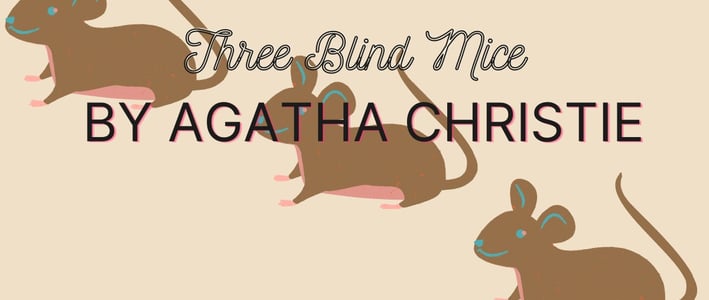Three Blind Mice Explained: Agatha Christie Insights
Discover the plot, suspense, and rich symbolism in Agatha Christie's classic tale 'Three Blind Mice'. Dive deep into the story's themes and meanings with our detailed analysis.
SHORT STORY


Three Blind Mice is a short story by Agatha Christie, first published in 1948. This study guide provides an analysis, summary, and interpretation based on my understanding of the story.
Three Blind Mice by Agatha Christie: A Comprehensive Analysis
Introduction to Three Blind Mice
Three Blind Mice is a gripping mystery by Agatha Christie, first published in 1948. Known for her brilliant twists and suspenseful storytelling, Christie has created one of the most enduring mysteries in literary history. Set in a secluded country house during a snowstorm, the story unravels a chilling tale of murder, deception, and hidden secrets. Originally a radio play for Queen Mary’s 80th birthday, Three Blind Mice was later adapted into a stage play, The Mousetrap, which became the longest-running play in history.
This analysis will delve into the plot, major themes, suspense-building techniques, and symbolism that make Three Blind Mice a timeless classic.
About the Author: Agatha Christie
Dame Agatha Christie (1890–1976) was an English novelist and playwright, often called the "Queen of Crime." She created iconic detectives such as Hercule Poirot and Miss Marple, and her works have been translated into over 100 languages. Christie is best known for her complex plots, unexpected twists, and her ability to keep readers guessing until the final reveal.
Plot Summary of Three Blind Mice
The story is set at Monkswell Manor, a remote guesthouse in the English countryside, isolated by a fierce winter storm. As the snow traps a group of strangers together, one of them is revealed to be a murderer. Detective Sergeant Trotter arrives to investigate and warns everyone that the killer is among them.
As tensions rise, the guests become increasingly suspicious of one another. Past secrets surface, and the investigation uncovers a web of deception. The story builds suspense through unexpected twists and shocking revelations, leading to a thrilling conclusion that leaves readers questioning everything they thought they knew.
Major Themes in Three Blind Mice
1. Murder and Mystery
Murder is the central element of Three Blind Mice. The discovery of a recent murder sets the stage for a series of events that lead to more tension, suspicion, and fear. The guests at the manor are forced to confront the mystery of who is responsible for the crime and why it was committed.
The story not only focuses on solving the murder but also examines the moral questions surrounding justice. The murder ties back to past wrongdoings, and as the story progresses, the characters must uncover the true motive to survive.
Three Blind Mice is a classic “whodunit,” where Christie masterfully uses red herrings and misdirection to keep readers guessing until the final twist.
2. Revenge and Justice
Revenge is a driving force behind many of the characters' actions. Past grievances and the desire for justice fuel much of the story’s tension. Christie explores how personal vendettas can lead to devastating consequences. The theme of justice is complex—characters must confront whether the revenge taken is morally right and justified.
The storyline raises important questions about the nature of justice: Can wrongdoings ever be truly forgiven? And how far will people go to seek justice for past crimes?
3. Isolation and Trust
Isolation is a key theme in Three Blind Mice. The characters are trapped in a remote guesthouse, cut off from the outside world by a snowstorm. This physical isolation heightens the psychological tension among the guests, all of whom harbor secrets and suspicions. The closed environment fosters distrust and paranoia, making it difficult for anyone to rely on one another.
Trust becomes a central issue as the investigation unfolds. Detective Trotter must figure out who to trust, and the guests must decide whether they can rely on one another for safety. The breakdown of trust adds to the suspense, driving the narrative to its dramatic climax.
Suspense-Building Techniques in Three Blind Mice
Christie uses several literary techniques to build suspense throughout the story:
1. Pacing
Christie masterfully controls the pacing, alternating between moments of calm and intense action. Just as the story seems to settle, a new clue or revelation heightens the tension, keeping readers on edge.
2. Foreshadowing
Subtle hints are scattered throughout the narrative, encouraging readers to form their own theories about the murder. These hints create a sense of impending danger, making the final twist all the more impactful.
3. Plot Twists
Three Blind Mice is filled with shocking twists that challenge readers' assumptions. Just when it seems like the mystery is solved, Christie throws in a new revelation, keeping readers hooked until the very end.
Symbolism in Three Blind Mice
The Nursery Rhyme
The title of the story, Three Blind Mice, is a reference to a nursery rhyme that plays a symbolic role in the plot. The rhyme, which tells the story of three blind mice who are hunted down, mirrors the fate of the characters in the story. It symbolizes innocence lost and the vulnerability of the guests, who are blind to the dangers lurking around them.
The Snowstorm
The snowstorm that traps the characters in the manor serves as a physical and metaphorical barrier, isolating them from the outside world and heightening the tension. It represents the emotional isolation that each character experiences, as well as the chilling atmosphere of fear and suspicion that envelops the guesthouse.
Reader Reactions and Interpretations
Since its release, Three Blind Mice has sparked discussions among readers. Some common interpretations include:
Justice vs. Morality: Is the revenge in the story justified, or does it cross ethical lines? This question has intrigued readers for years.
Psychological Depth: Christie delves deeply into the motivations and emotions of her characters, making them more than just suspects—they feel like real people with complex histories.
The Twist: The unexpected ending is a major talking point. While some readers love the twist, others debate its fairness, making it one of the most memorable aspects of the story.
Conclusion
Three Blind Mice showcases Agatha Christie’s unparalleled talent for suspense and mystery. With its clever plot twists, rich psychological depth, and complex themes, it remains one of her most celebrated works. The story challenges readers to question perception, justice, and trust, all while delivering a thrilling and unforgettable experience.
If you enjoyed Three Blind Mice, be sure to explore more of Agatha Christie’s works to experience more timeless mysteries that continue to captivate readers worldwide.
What did you think of the twist in Three Blind Mice? Share your thoughts in the comments below!
Want more classic mystery breakdowns? Explore our literature section for more Agatha Christie analyses and other legendary works!Three Blind Mice Explained: Plot, Themes, Suspense, and Symbolism in Agatha Christie's Classic Mystery
